Characteristics and Formation Mechanism of the Lower Paleozoic Dolomite Reservoirs in the Dongying Depression, Bohai Bay Basin
Abstract
:1. Introduction
2. Geological Setting
3. Analytical Methods
4. Results
4.1. Petrography
4.1.1. Argillaceous Dolomite (M1)
4.1.2. Microcrystalline Dolomite (M2)
4.1.3. Fine-Crystalline Dolomite (M3)
4.1.4. Powder-to-Fine-Crystalline Dolomite Cements (D1)
4.1.5. Fine-Crystalline Ferroan Dolomite Cements (D2)
4.1.6. Medium-to-Coarse-Crystalline Dolomite Cements (D3)
4.1.7. Saddle Dolomite (D4)
4.2. Dolomite Reservoir Characteristics
4.2.1. Pore
Moldic Pore
Intercrystalline Pore
Dissolution Vugs
4.2.2. Fracture
4.3. Isotope Data
4.3.1. Stable Isotopes
4.3.2. Strontium Isotope
5. Discussion
5.1. Diagenesis of the Dolomite Reservoir
5.1.1. Dolomitization
5.1.2. Dissolution
5.1.3. Fracturing and Cementation
5.1.4. Compaction and Pressure Solution
5.2. Origins of the Different Types of Dolomite
5.2.1. Matrix Dolomites
5.2.2. Powder-to-Fine-Crystalline Dolomite Cements (D1)
5.2.3. Fine-Crystalline Ferroan Dolomite Cements (D2) and Medium-to-Coarse-Crystalline Dolomite Cements (D3)
5.2.4. Saddle Dolomite (D4)
5.3. Implications for Porosity Development
5.3.1. Diagenetic Pore Evolution
5.3.2. The Influence of Diagenesis on Reservoir Properties
6. Conclusions
Author Contributions
Funding
Institutional Review Board Statement
Informed Consent Statement
Data Availability Statement
Acknowledgments
Conflicts of Interest
References
- Bai, G.P. Distribution patterns of giant carbonate fields in the world. J. Palaeogeogr. (Chin. Ed.) 2006, 8, 241–250. [Google Scholar]
- Halbouty, M.T. Giant Oil and Gas Fields of the Decade 1990–1999. AAPG Memoir. In Proceedings of the 4th AAPG Conference, Denver, CO, USA, 7–10 April 1991. [Google Scholar]
- Zhao, W.Z.; Shen, A.J.; Zheng, J.F.; Qiao, Z.F.; Wang, X.F.; Lu, J.M. Discussion on pore genesis of dolomite reservoirs in Tarim, Sichuan and Ordos Basin and its guiding significance to reservoir prediction. Sci. Sin. 2014, 44, 1925–1939. [Google Scholar]
- Zhang, J.T.; Jin, X.H.; Gu, N.; Bian, C.R.; Yang, J.Q.; He, Y.L. Differences and development patterns of karst reservoirs in Majiagou Formation, northern Ordos Basin. Oil Gas Geol. 2021, 42, 1159–1168. [Google Scholar]
- Hao, Y.; Zhou, J.G.; Zhang, J.Y.; Ni, C.; Gu, M.F.; Xin, Y.G. Characteristics and controlling factors of dolomite reservoir of Middle Permian Qixia Formation in northwest Sichuan Basin. Sediment. Geol. Tethyan Geol. 2013, 33, 68–74. [Google Scholar]
- Hu, A.P.; Pan, L.Y.; Hao, Y.; Shen, A.J.; Gu, M.F. Origin, Characteristics and Distribution of Dolostone Reservoir in Qixia Formation and Maokou Formation, Sichuan Basin, China. Mar. Orig. Pet. Geol. 2018, 23, 39–52. [Google Scholar]
- Shu, X.H.; Zhang, J.T.; Li, G.R.; Long, S.X.; Wu, S.X.; Li, H.T. Characteristics and genesis of hydrothermal dolomites of Qixia and Maokou Formations in northern Sichuan Basin. Oil Gas Geol. 2012, 33, 442–448. [Google Scholar]
- Zhu, Y.D.; Jin, Z.Y.; Sun, D.S.; Deng, Y.M.; Zhang, R.Q.; Yuan, Y.R. Hydrothermal dolomitization of Sinian Dengying Formation in south China and its influence on reservoir formation: A case study of Central Guizhou Uplift. Chin. J. Geol. (Sci. Geol. Sin.) 2014, 49, 161–175. [Google Scholar]
- Ma, Y.S.; Guo, T.L.; Zhao, X.F.; Cai, X.Y. Formation mechanism of deep high-quality dolomite reservoir in Puguang Gasfield. Sci. Sin. 2007, 37, 43–52. [Google Scholar]
- Zheng, H.R.; Wu, M.B.; Wu, X.W.; Zhang, T.; Liu, C.Y. Oil-gas exploration prospect of dolomite reservoir in the Lower Paleozoic of Tarim Basin. Acta Pet. Sin. 2007, 28, 1–8. [Google Scholar]
- Sibley, D.F. Climatic Control of Dolomitization, Seroe Domi Formation (Pliocene), Bonaire, NA; The Society of Economic Paleontologists and Mineralogists: East Lansing, MI, USA, 1980; pp. 247–258. [Google Scholar]
- Shinn, E.A.; Ginsburg, R.N.; Lloyd, R.M. Recent Supratidal Dolomite from Andros Island, Bahamas. In Dolomitization and Limestone Diagenesis; Pray, L.C., Murray, R.C., Eds.; SEPM Society for Sedimentary Geology: Tulsa, OK, USA, 1965; pp. 112–113. [Google Scholar]
- Vasconcelos, C.; Bernasconi, S.; Grujic, D.; Tien, A.J.; Mckenzie, J.A. Microbial mediation as a possible mechanism for natural dolomite formation at low temperatures. Nature 1995, 377, 220–222. [Google Scholar] [CrossRef]
- Vasconcelos, C.; Mckenzie, J.A. Microbial mediation of modern dolomite precipitation and diagenesis under anoxic conditions (Lagoa Vermelha, Rio de Janeiro, Brazil). J. Sediment. Res. 1997, 67, 378–390. [Google Scholar]
- Jiang, L.; Pan, W.; Cai, C.; Jia, L.; Pan, L.; Wang, T.; Li, H.; Chen, S.; Chen, Y. Fluid mixing induced by hydrothermal activity in the ordovician carbonates in Tarim Basin, China. Geofluids 2015, 15, 483–498. [Google Scholar] [CrossRef]
- Smith, L.B. Origin and reservoir characteristics of Upper Ordovician Trenton–Black River hydrothermal dolomite reservoirs in New York. AAPG Bull. 2006, 90, 1691–1718. [Google Scholar] [CrossRef] [Green Version]
- Davies, G.R.; Smith, L.B. Structurally controlled hydrothermal dolomite reservoir facies: An overview. AAPG Bull. 2006, 90, 1641–1690. [Google Scholar] [CrossRef]
- Spencer, C.C.; Mullis, J. Chemical study of tectonically controlled hydrothermal dolomitization: An example from the Lessini Mountains, Italy. Geol. Rundsch. 1992, 81, 347–370. [Google Scholar] [CrossRef]
- White, T.; Al-Aasm, I.S. Hydrothermal dolomitization of the Mississippian Upper Debolt Formation, Sikanni gas field, northeastern British Columbia, Canada. Bull. Can. Pet. Geol. 1997, 45, 297–316. [Google Scholar]
- Ronchi, P.; Masetti, D.; Tassan, S.; Camocino, D. Hydrothermal dolomitization in platform and basin carbonate successions during thrusting: A hydrocarbon reservoir analogue (Mesozoic of Venetian Southern Alps, Italy). Mar. Pet. Geol. 2012, 29, 68–89. [Google Scholar] [CrossRef]
- Du, Y.L.; Li, S.Y.; Wang, B.; Zhao, D.Q.; Yang, D.D. Diagenesis of the Lower-Middle Permian Carbonate in the Wuwei-Chaohui area, Anhui Province. Acta Geol. Sin. 2011, 85, 543–556. [Google Scholar]
- Giles, M.R.; De Boer, R.B. Origin and significance of redistributional secondary porosity. Mar. Pet. Geol. 1990, 7, 378–397. [Google Scholar] [CrossRef]
- Ali, M.Y. Carbonate cement stratigraphy and timing of diagenesis in a Miocene mixed carbonate-clastic sequence, offshore Sabah, Malaysia: Constraints from cathodoluminescence, geochemistry, and isotope studies. Sediment. Geol. 1995, 99, 191–214. [Google Scholar]
- Paradis, S.; Lavoie, D. Multiple-stage diagenetic alteration and fluid history of Ordovician carbonate-hosted barite mineralization, Southern Quebec Appalachians. Sediment. Geol. 1996, 107, 121–139. [Google Scholar] [CrossRef]
- Heydari, E. Porosity loss, fluid flow, and mass transfer in limestone reservoirs: Application to the Upper Jurassic Smackover formation, Mississippi. AAPG Bull. 2000, 84, 100–118. [Google Scholar]
- Esteban, M.; Taberner, C. Secondary porosity development during late burial in carbonate reservoirs as a result of mixing and/or cooling of brines. J. Geochem. Explor. 2003, 78, 355–359. [Google Scholar] [CrossRef]
- Wang, L.; Shi, J.A.; Wang, Q.; Wang, J.P.; Zhao, X.; Sun, X.J.; Zhao, L.B. Analysis on main controlling factors of Ordovician carbonate reservoir in southwest margin of Ordos Basin. Pet. Geol. Recovery Effic. 2005, 12, 10–13. [Google Scholar]
- Choquette, P.W.; Cox, A.; Meyers, W.J. Characteristics, distribution and origin of porosity in shelf dolostones; Burlington-Keokuk Formation (Mississippian), US Mid-Continent. J. Sediment. Res. 1992, 62, 167–189. [Google Scholar]
- Xie, G.P. Diagenesis and Porosity Evolution of Crystal Garin Dolomite in the Upper Section of the 4th Member of Leikoupo Formation in the Western Sichuan Depression. J. Yangtze Univ. (Nat. Sci. Ed.) 2015, 12, 24–26. [Google Scholar]
- Mo, J.; Wang, X.Z.; Xie, L.; Zhou, Z.; Lin, G.; Xiong, J.W. Diagenesis and Pore Evolution of Carbonate in Sinian Dengying Formation in Central Sichuan Province. J. Oil Gas Technol. 2013, 35, 32–38. [Google Scholar]
- Lavoie, D.; Jackson, S.; Girard, I. Magnesium isotopes in high-temperature saddle dolomite cements in the lower Paleozoic of Canada. Sediment. Geol. 2014, 305, 58–68. [Google Scholar] [CrossRef]
- Biehl, B.C.; Reuning, L.; Schoenherr, J.; Lüders, V.; Kulka, P.A. Impacts of hydrothermal dolomitization and thermochemical sulfate reduction on secondary porosity creation in deeply buried carbonates: A case study from the Lower Saxony Basin, northwest Germany. AAPG Bull. 2016, 100, 597–621. [Google Scholar] [CrossRef]
- Ardiansyah, K.; Hilary, C.; Jack, S.; Peter, K.S.; Adrian, B.; Hamish, R.; Fiona, W.; Cathy, H. Evaluating new fault controlled hydrothermal dolomitization models: Insights from the Cambrian Dolomite, Western Canadian Sedimentary Basin. Sedimentology 2020, 67, 2945–2973. [Google Scholar]
- Huang, S.J.; Wang, C.M.; Huang, B.B.; Zou, M.L.; Wang, Q.D.; Gao, X.Y. Scientific research frontiers and considerable questions of carbonate diagenesis. J. Chengdu Univ. Technol. (Sci. Technol. Ed.) 2008, 35, 1–10. [Google Scholar]
- Liu, W.; Xiao, C.T.; Lv, Y.L. Analysis of Burid-hill Reservoir Forming Conditions in the East Section of South Slope of Dongying Depression. J. Oil Gas Technol. 2004, 26, 6–7. [Google Scholar]
- Ge, X. Buried Hill Reservoir Forming Research of Ordovician System in Caoqiao Oilfield. Master’s Thesis, Ocean University of China, Qingdao, China, 2015. [Google Scholar]
- Qiu, Z.J. Study on the Geological Characteristics and Control Factors of Caoqiao Buried Hill Reservoir in Dongying Depression, Shandong. Master’s Thesis, Kunming University of Science and Technology, Kunming, China, 2016. [Google Scholar]
- Jiang, W. Characteristics of High-Quality Reservoir of the Palezoic Carbonate Buried Hills in the Donging Depression. Master’s Thesis, China University of Petroleum (East China), Dongying, China, 2017. [Google Scholar]
- Wei, X. Evaluation of Karst Reservoir in the Ordovician Badou Formation in the Zhuanghai Area, Jiyang Depression. Master’s Thesis, Chengdu University of Technology, Chengdu, China, 2019. [Google Scholar]
- Guo, Y.X. A study on constructive diagenesis of the dolomite reservoir within the Yeli-Liangjiashan Formation In the ZHuanghai area of Jiyang Depression. Acta Mineral. Sin. 2021, 41, 163–170. [Google Scholar]
- Li, C.G. Control of fault systems on oil and gas distribution in Dongying Depression. Oil Gas Geol. 1994, 15, 87–93. [Google Scholar]
- Xiong, Z.; Wang, L.S.; Li, C.; Shi, X.B.; Guo, S.P.; Wang, J. Distribution geotemperature in Dongying Depression, Shengli oil and gas field, North China basin. Geol. J. China Univ. 1999, 5, 312–321. [Google Scholar]
- Jiang, Y.L.; Rong, Q.H. Formation pattern of oil-gas pools and distribution of hydrocarbon in Gaoqing area. Pet. Geol. Exp. 1998, 20, 14–19. [Google Scholar]
- Chen, X.; Cao, Y.C.; Yuan, G.H.; Wang, Y.Z.; Zan, N.M. Origin and distribution model of the lower Paleozoic carbonata reservoirs in Pingfangwang-Pingnan buried hills, Dongying Sag. J. China Univ. Pet. (Ed. Nat. Sci.) 2020, 44, 1–14. [Google Scholar]
- Li, G.Y. Atlas of China’s Petroliferous Basins; Petroleum Industry Press: Beijing, China, 2002; pp. 58–276. [Google Scholar]
- Fan, C.T.; Feng, Y.L.; Fu, J.P. Analysis on conditions and rules of reservoir forming of buried hill in Dongying sag. Pet. Geol. Recovery Effic. 2002, 9, 35–37. [Google Scholar]
- Zan, N.M.; Wang, Y.Z.; Cao, Y.C.; Yuan, G.H.; Chen, X.; Jiang, W.; Zhai, G.H.; Song, M.S. Characteristics and development of reservoir space of the Lower Paleozoic buried hills in Dongying Sag, Bohai Bay Basin. Oil Gas Geol. 2018, 39, 355–365. [Google Scholar]
- Lin, S.H.; Wang, H.; Zhang, G.X.; Wu, Y.X.; Chen, H.Y.; Wei, H.B. Pool features of buried hill in west part of Dongying Depression. Oil Gas Geol. 2000, 21, 360–363. [Google Scholar]
- Tian, Y.M. Structural Evolution and Oil-Gas Accumulation Analysis of Buried Hill in the South of Dongying Sag, Bohaiwan Basin. Master’s Thesis, Chengdu University of Technology, Chengdu, China, 2005. [Google Scholar]
- Machel, H.G. Saddle dolomite as a by-product of chemical compaction and thermochemical sulfate reduction. Geology 1987, 15, 836–940. [Google Scholar] [CrossRef]
- Dun, T.J. Reservoir research status and development trend. Northwestern Geol. 1995, 16, 1–15. [Google Scholar]
- Xue, H.; Han, C.Y.; Xiao, B.Y.; Han, J.Y. Origin of Reservoirs in the Lower Cambrian Xiaoerbulak Formation, Tarim Basin. Acta Sedimentol. Sin. 2019, 43, 79–88. [Google Scholar]
- Jin, C.G.; Liu, J.W. Characteristics of Ordovician Karst reservoir in southern Zhidan, Ordos Basin. Ground Water 2016, 38, 239–241. [Google Scholar]
- Yang, N.; Lü, X.X.; Pan, W.Q. Feature of fracture development in Ordovician carbonate reservoir of Lunnan burial hill. J. Xi’an Shiyou Univ. (Nat. Sci. Ed.) 2004, 19, 40–42. [Google Scholar]
- Zhao, J.L.; Gong, Z.W.; Li, G.; Feng, C.Y.; Bai, X.; Jian, J.; Fu, B.; Hong, Y. A review and perspective of identifying and evaluating the logging technology of fractured carbinate reservoir. Prog. Geophys. 2012, 27, 537–547. [Google Scholar]
- Burke, W.H. Variation of seawater 87Sr/86Sr throughout Phanerozoic time. Geology 1982, 10, 516–519. [Google Scholar] [CrossRef]
- Mcarthur, J.M.; Howarth, R.J.; Bailey, R.T. Strontium Isotope Stratigraphy: LOWESS Version 3: Best Fit to the Marine Sr-Isotope Curve for 0–509 Ma and Accompanying Look-up Table for Deriving Numerical Age. J. Geol. 2001, 109, 155–170. [Google Scholar] [CrossRef] [Green Version]
- Gregg, J.M.; Shelton, K.L. Dolomitization and dolomite neomorphism in the back reef facies of the Bonneterre and Davis formations (Cambrian), southeastern Missouri. J. Sediment. Res. 1990, 60, 549–562. [Google Scholar]
- Land, L.S. The application of stable isotopes to studies of the origin of dolomite and to problems of diagenesis of clastic sediments. In Stable Isotope in Sedimentary Geology (SC10); Arthur, M., Anderson, T., Kaplan, I., Veiser, J., Land, L., Eds.; The Society of Economic Paleontologists and Mineralogists (SEPM): Tulsa, Oklahoma, USA, 1983; Chapter 4. [Google Scholar]
- Veizer, J.; Bruckschen, P.; Pawellek, F.; Diener, A.; Ala, D. Oxygen isotope evolution of Phanerozoic seawater. Palaeogeogr. Palaeocl. 1997, 132, 159–172. [Google Scholar] [CrossRef]
- Friedman, I.; O’Neil, J.R. Compilation of Stable Isotope Fractionation Factors of Geochemical Interest; United States Government Printing Office: Washington, DC, USA, 1977; Volume 440, Chapter KK. [Google Scholar]
- Kinsman, D.J.J. Gypsum and anhydrite of recent age, Trucial Coast, Persian Gulf. North. Ohio Geol. Soc. Clevel. Ohio 1966, 1, 302–326. [Google Scholar]
- Machel, H.G. Concepts and models of dolomitization: A critical reappraisal. Geol. Soc. Lond. Spec. Publ. 2004, 235, 7–63. [Google Scholar] [CrossRef]
- Adams, J.E.; Rhodes, M.L. Dolomitization by seepage refluxion. AAPG Bull. 1960, 44, 1912–1920. [Google Scholar]
- Wang, S.H.; Song, G.Q.; Xu, C.H.; Chen, L. Early Palaeozoic Sedimentary Facies in the Shengli Oil Province, North China Platform. Sediment. Facies Palaeogeogr. 1997, 17, 34–40. [Google Scholar]
- Sibley, D.F.; Gregg, J.M. Classification of dolomite rock textures. J. Sediment. Res. 1987, 57, 967–975. [Google Scholar]
- Merino, E.; Canals, À. Self-accelerating dolomite-for-calcite replacement: Self-organized dynamics of burial dolomitization and associated mineralization. Am. J. Sci. 2011, 311, 573–607. [Google Scholar] [CrossRef]
- Dunnington, H.V. Stylolite development post-dates rock induration. J. Sediment. Res. 1954, 24, 27–49. [Google Scholar] [CrossRef]
- Tang, J.C.; Chen, H.H.; Wang, J.H.; Chen, K.Q.; Qi, K.L. The Diagenesis of the Upper Paleozoic Carbonate Rocks in the Southeast Xiang Depression. J. Southwest Pet. Univ. (Sci. Technol. Ed.) 2007, 29, 43–46. [Google Scholar]
- Beaudoin, N.; Koehn, D.; Lacombe, O.; Lecouty, A.; Billi, A.; Aharonov, E.; Parlangeau, C. Fingerprinting stress: Stylolite and calcite twinning paleopiezometry revealing the complexity of progressive stress patterns during folding—The case of the Monte Nero anticline in the Apennines, Italy. Tectonics 2016, 35, 1687–1721. [Google Scholar] [CrossRef] [Green Version]
- Veizer, J.; Ala, D.A.K.; Bruckschen, P.; Buhl, D.; Bruhn, F.; Carden, G.A.F.; Diener, A.; Ebneth, S.; Godderis, Y. 87Sr/86Sr, δ13C and δ18O evolution of Phanerozoic seawater. Chem. Geol. 1999, 161, 59–88. [Google Scholar] [CrossRef] [Green Version]
- Friedman, G.M. Highest Phanerozoic strontium isotopic ratios of pre-rift Late Cambrian passive margin in New York State, USA: Products of continental weathering and orogenesis. Sediment. Geol. 2002, 147, 143–153. [Google Scholar] [CrossRef]
- Gregg, J.M.; Sibley, D.F. Epigenetic dolomitization and the origin of xenotopic dolomite texture. J. Sediment. Res. 1984, 54, 908–931. [Google Scholar]
- Zhang, J.T.; He, Y.L.; Yue, X.J.; Sun, Y.P.; Jin, X.J. Genesis of iron-rich dolostones in the 5th member of the Majiagou Formation of the Ordovician in Ordos Basin. Oil Gas Geol. 2017, 38, 776–783. [Google Scholar]
- Zheng, C.B.; Zhang, G.S.; Wang, F.Y. Hot Water Karst Characteristics of Ordovician Period in Ordos Basin. Acta Sedimentol. Sin. 2001, 19, 524–529. [Google Scholar]
- He, P.W.; Xu, W.; Zhang, L.J.; Fu, M.Y.; Wu, D.; Deng, H.C.; Xu, H.L.; Sun, Q.M. Characteristics and Genetic Mechanism of Qixia Formation Dolomite in Moxi-Gaoshiti Area, Central Sichuan Basin. Acta Sedimentol. Sin. 2021, 39, 1532–1545. [Google Scholar]
- Li, P.L.; Zhang, S.W.; Wang, Y.S. Genesis, Accumulation and Exploration of Diversity Buried Hill: A Case Study of Jiyang Depression; Petroleum Industry Press: Beijing, China, 2003; pp. 30–120. [Google Scholar]
- Fisher, R.S.; Land, L.S. Diagenetic history of Eocene Wilcox sandstones, South-Central Texas. Geochim. Cosmochim. Acta 1986, 50, 551–561. [Google Scholar] [CrossRef]
- Xia, B.; Huang, X.X.; Cai, Z.R.; Jia, H.Y.; Lu, B.F.; Wang, R. Relationship Between Tectonics and Hydrocarbon Reservoirs from Indo-Chinese Epoch to Stage of Yanshan in Jiyang Depression. Nat. Gas Geosci. 2007, 18, 832–837. [Google Scholar]
- Li, D.S. Tectonic pattern of Bohai Bay petroliferous basin. Pet. Explor. Dev. 1979, 2, 1–10. [Google Scholar]
- Kang, Y.; Zou, L.; Liu, Z.Y.; Han, M.; Lu, H.; Yao, S.C. Fault structure and its effect on oil-gas reservoir forming in Qingcheng arch. Pet. Geol. Recovery Effic. 2014, 21, 45–48. [Google Scholar]
- Yang, P.R.; Chen, J.; Cai, J.G.; Yang, H.Y. Structural transitional stages in Jiyang depression and their significance on petroleum geology. Pet. Geol. Recovery Effic. 2001, 8, 5–7. [Google Scholar]
- Qiu, N.S.; Li, S.P.; Zeng, J.H. Thermal History and Tectonic-thermal Evolution of the Jiyang Depression in the Bohai Bay Basin, East China. Acta Geol. Sin. 2004, 78, 263–269. [Google Scholar]
- Faure, G.; Mensing, T.M. Isotopes: Principles and Applications, 3rd ed.; Wiley: Columbus, OH, USA, 2004; pp. 363–460. [Google Scholar]
- Epstein, S.; Buchsbaum, R.; Lowenstam, H.; Urey, H.C. Revised carbonate-water isotopic temperature scale. Geol. Soc. Am. Bull. 1953, 64, 1315–1326. [Google Scholar] [CrossRef]
- Grossman, E.L.; Ku, T.L. Oxygen and carbon isotope fractionation in biogenic aragonite: Temperature effects. Chem. Geol. Isot. Geosci. Sect. 1986, 59, 59–74. [Google Scholar] [CrossRef]
- Smith, L.B.; Davies, G.R. Structurally controlled hydrothermal alteration of carbonate reservoirs: Introduction. AAPG Bull. 2006, 90, 1635–1640. [Google Scholar] [CrossRef]
- Mattey, D.; Lowry, D.; Macpherson, C. Oxygen isotope composition of mantle peridotite. Earth Planet. Sci. Lett. 1994, 128, 231–241. [Google Scholar] [CrossRef]
- Wu, Q. Fault System and Tectonic Evolution of Mesozoic-Paleozoic in Gaoqing Area. Master’s Thesis, China University of Petroleum (East China), Dongying, China, 2017. [Google Scholar]
- Cai, J.X. Characteristics and genesis mechanism of stylolite. Acta Petrol. Sin. 1990, 5, 51–61. [Google Scholar]
- Murray, R.C. Origin of porosity in carbonate rocks. J. Sediment. Res. 1960, 30, 59–84. [Google Scholar] [CrossRef]
- Waldschmidt, W.A.; Fitzgerald, P.E.; Lunsford, C.L. Classification of Porosity and Fractures in Reservoir Rocks1. AAPG Bull. 1956, 40, 953–974. [Google Scholar]
- Qian, Y.X.; He, Y.L.; Chen, Q.L.; Li, H.L.; Lu, Q.H.; Cai, X.R.; You, D.H. Sealing capacity of the Ordovician carbonate rocks in Tazhong area, the Tarim Basin. Oil Gas Geol. 2012, 33, 1–9. [Google Scholar]
- Katz, D.A.; Eberli, G.P.; Swart, P.K.; Smith, L.B. Tectonic-hydrothermal brecciation associated with calcite precipitation and permeability destruction in Mississippian carbonate reservoirs, Montana and Wyoming. AAPG Bull. 2006, 90, 1803–1841. [Google Scholar] [CrossRef] [Green Version]
- Huang, Q.Y.; Zhang, X.N.; Zhang, S.Y.; Liu, D.; Ye, N. Textural Control on the Development of Dolomite Reservoir: A study from the Cambrian-Ordovician Dolomite,Central Tarim Basin, NW China. Nat. Gas Geosci. 2014, 25, 341–350. [Google Scholar]
- Hou, G.T.; Qian, X.L.; Song, X.M.; Fan, L.X.; Xu, S.G. The Origin of Car bondioxide Gas Fields in J iyang Basin. Acta Sci. Nat. Univ. Pekin. 1996, 32, 35–41. [Google Scholar]
- Zeng, J.H.; Jin, Z.Y.; Zhang, L.P. Mantle-derived fluid activity characteristics and reservoir-forming effect of Gaoqing-Pingnan fault zone in Dongying Depression. Geol. Rev. 2004, 50, 501–506. [Google Scholar]
- Li, Y.; Yan, Y.S.; Song, Z.J.; Tang, Z.Q. Study on Fracture Movement and Petroleum Poo-l matured Phases of Pingnan Oilfield —Based on the Evidence of Liquid Inclusions. J. Shandong Univ. Sci. Technol. (Nat. Sci.) 2010, 29, 14–19. [Google Scholar]
- Shang, X.F.; Sun, X.J. The influences of Organic Liquid’s on Reservoir Diagenesis-Taking Dongying Sag as an Example. J. Libr. Inf. Sci. 2011, 21, 184–188. [Google Scholar]
- Sun, S.Q. Dolomite Reservoirs: Porosity Evolution and Reservoir Characteristics. AAPG Bull. 1995, 79, 186–204. [Google Scholar]
- Hugman, R.H.H.; Friedman, M. Effects of texture and composition on mechanical behavior of experimentally deformed carbonate rocks. AAPG Bull. 1978, 63, 1478–1489. [Google Scholar]
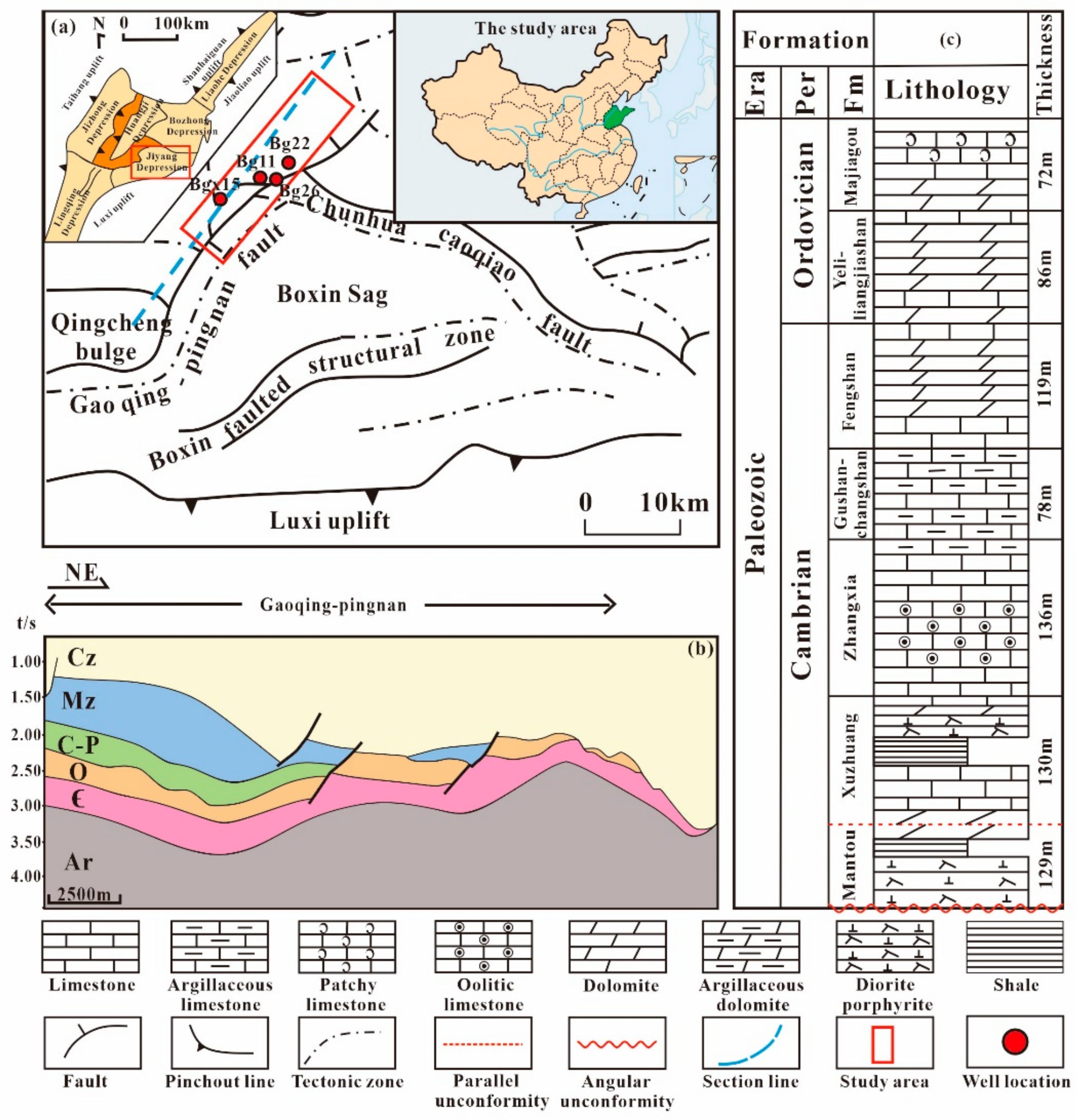
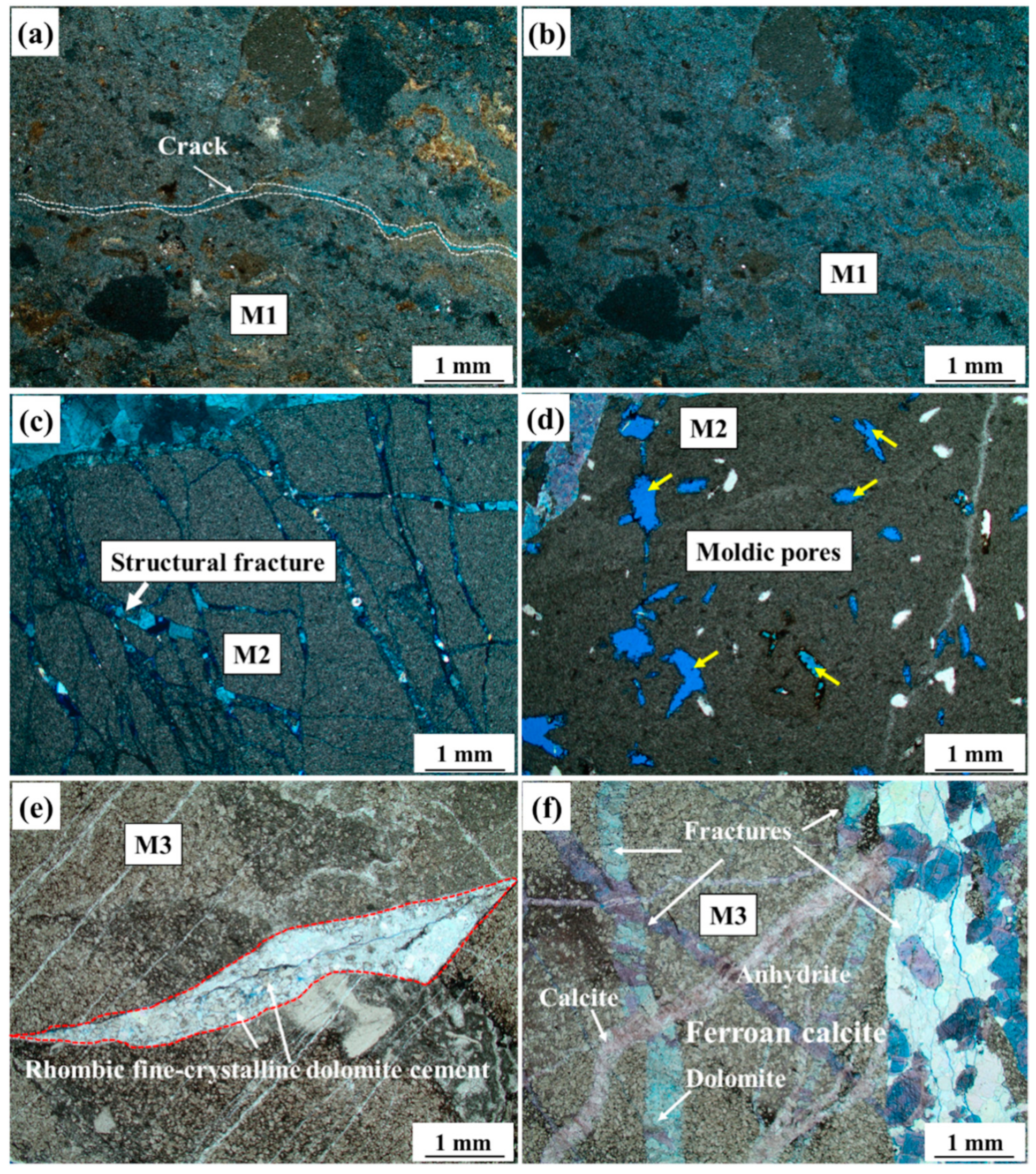
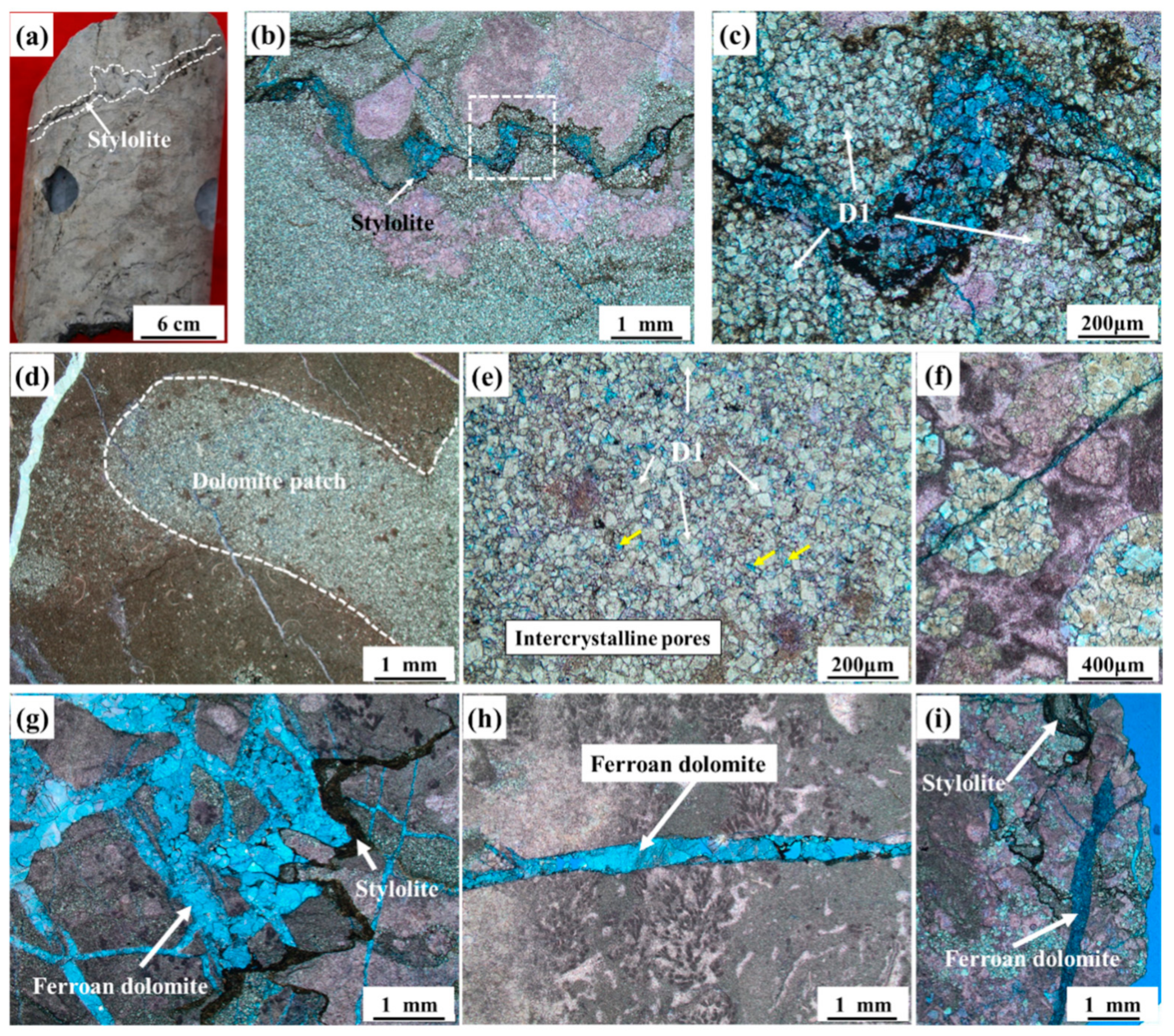
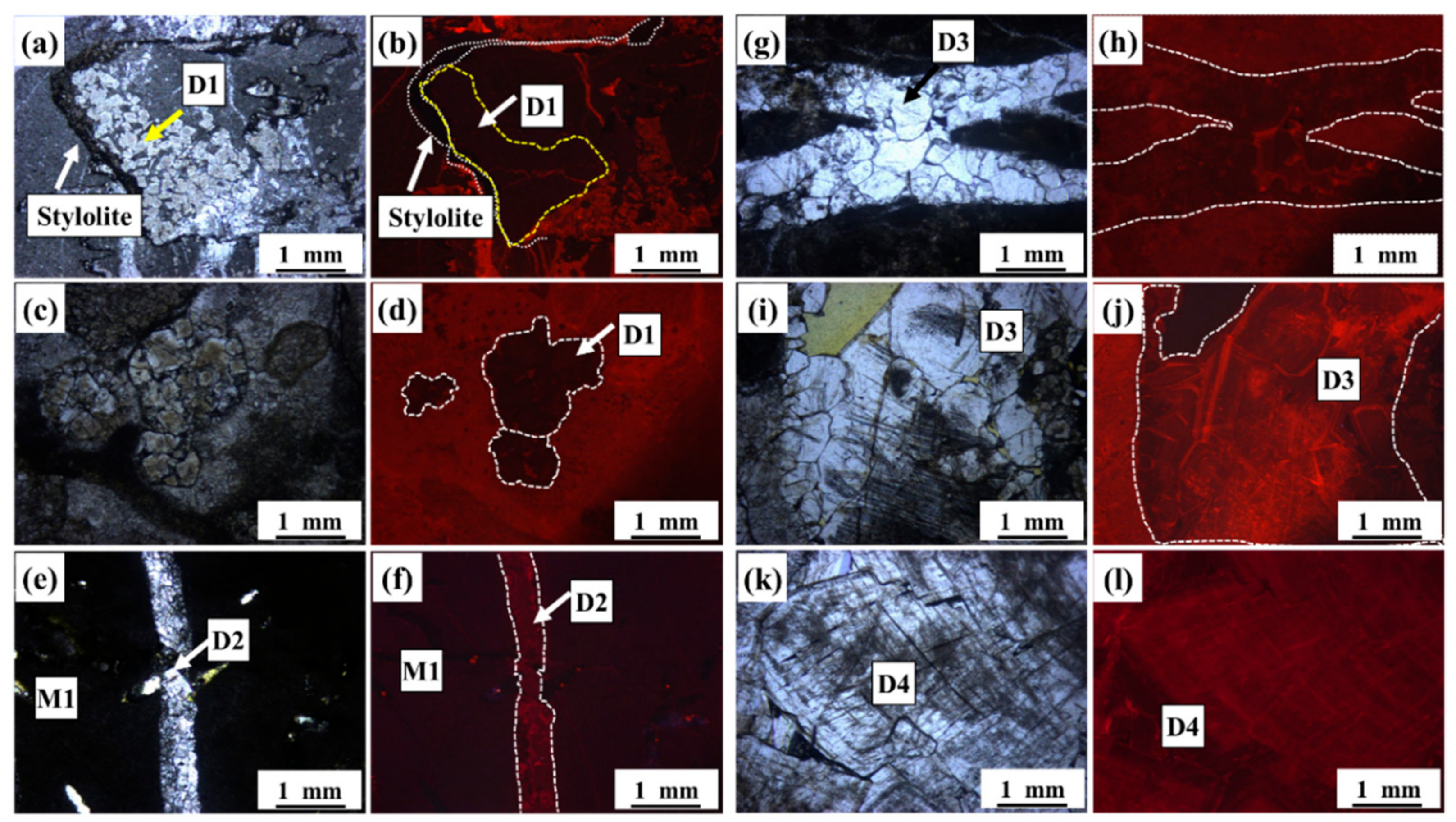
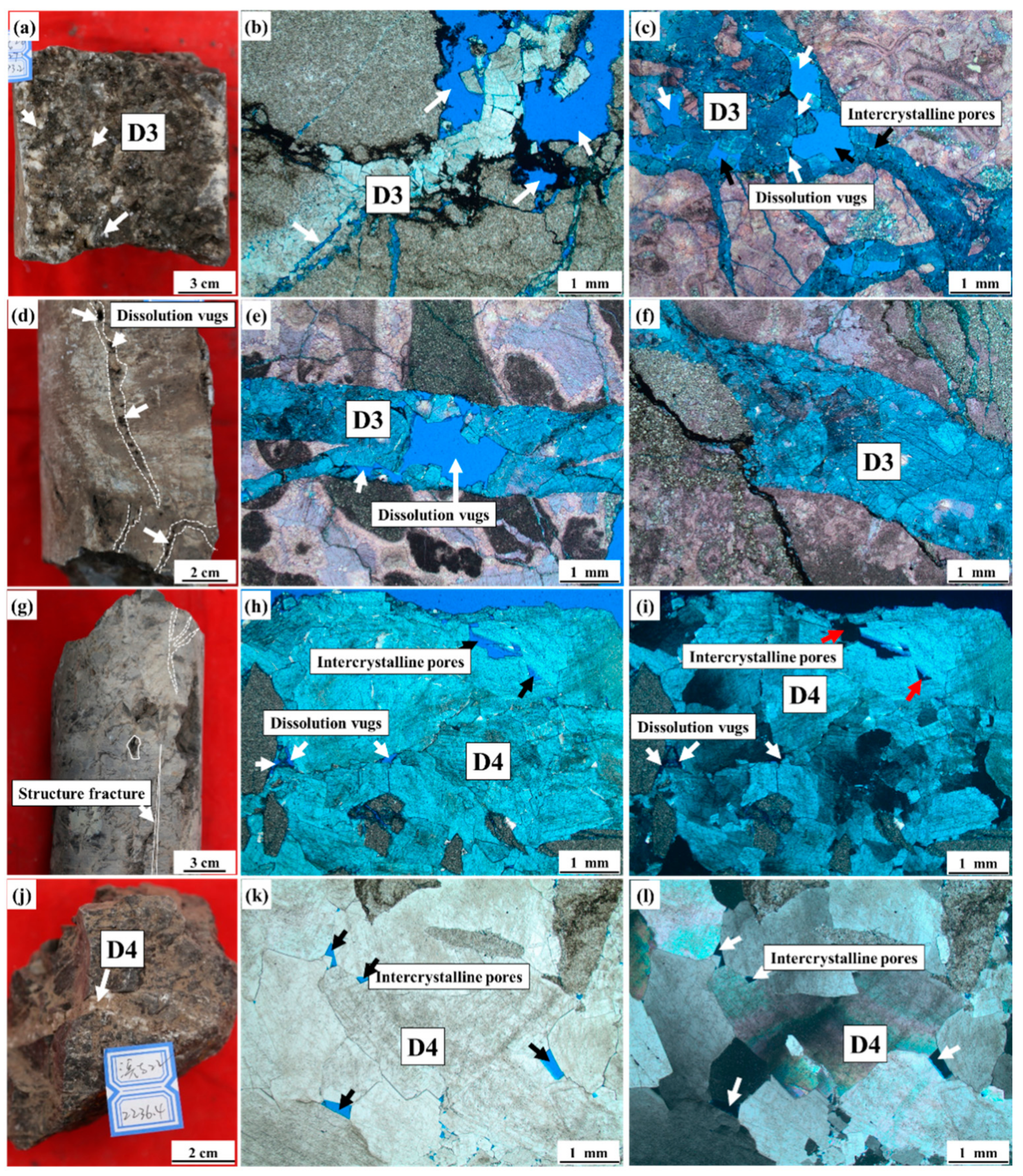
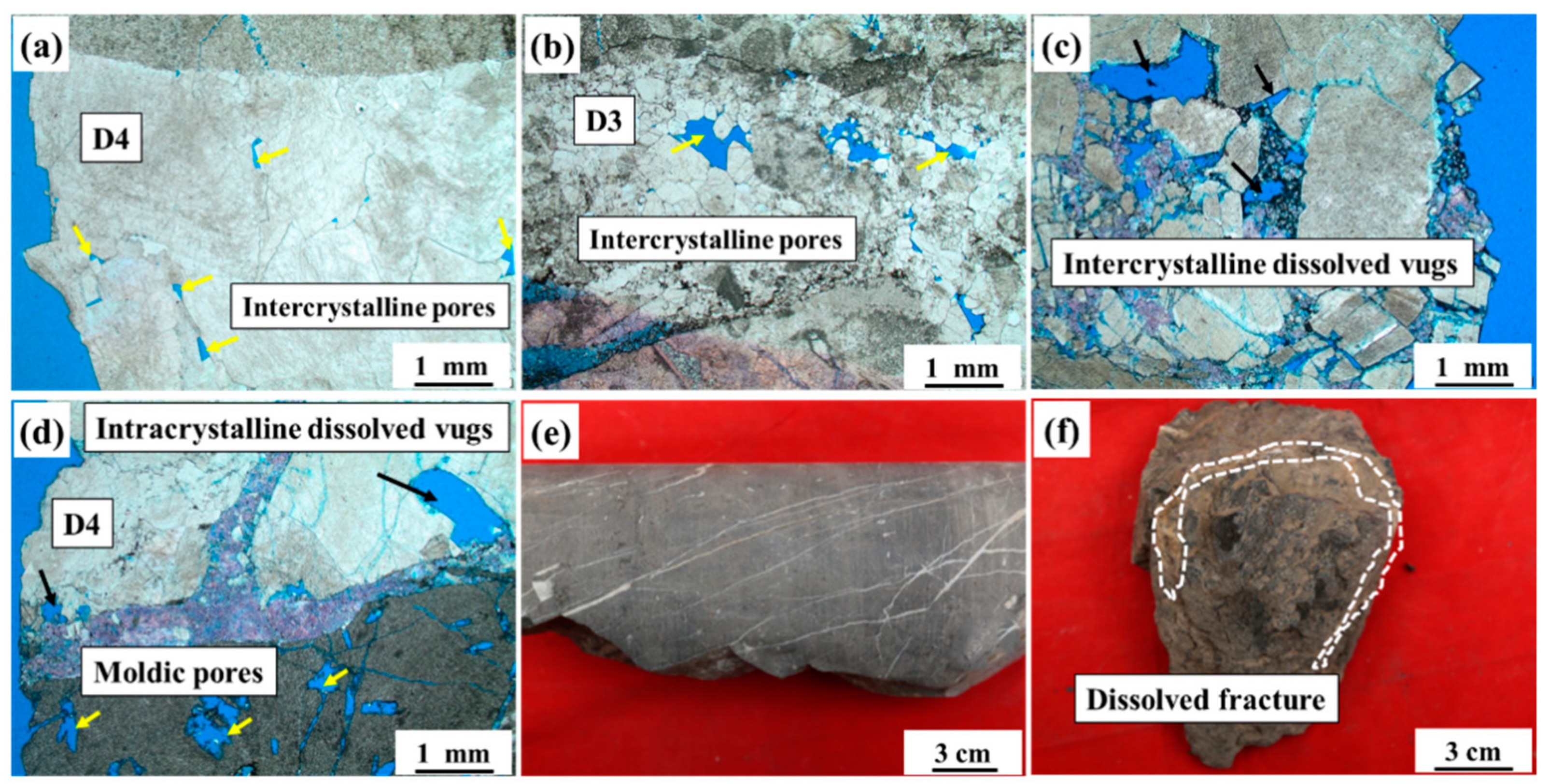
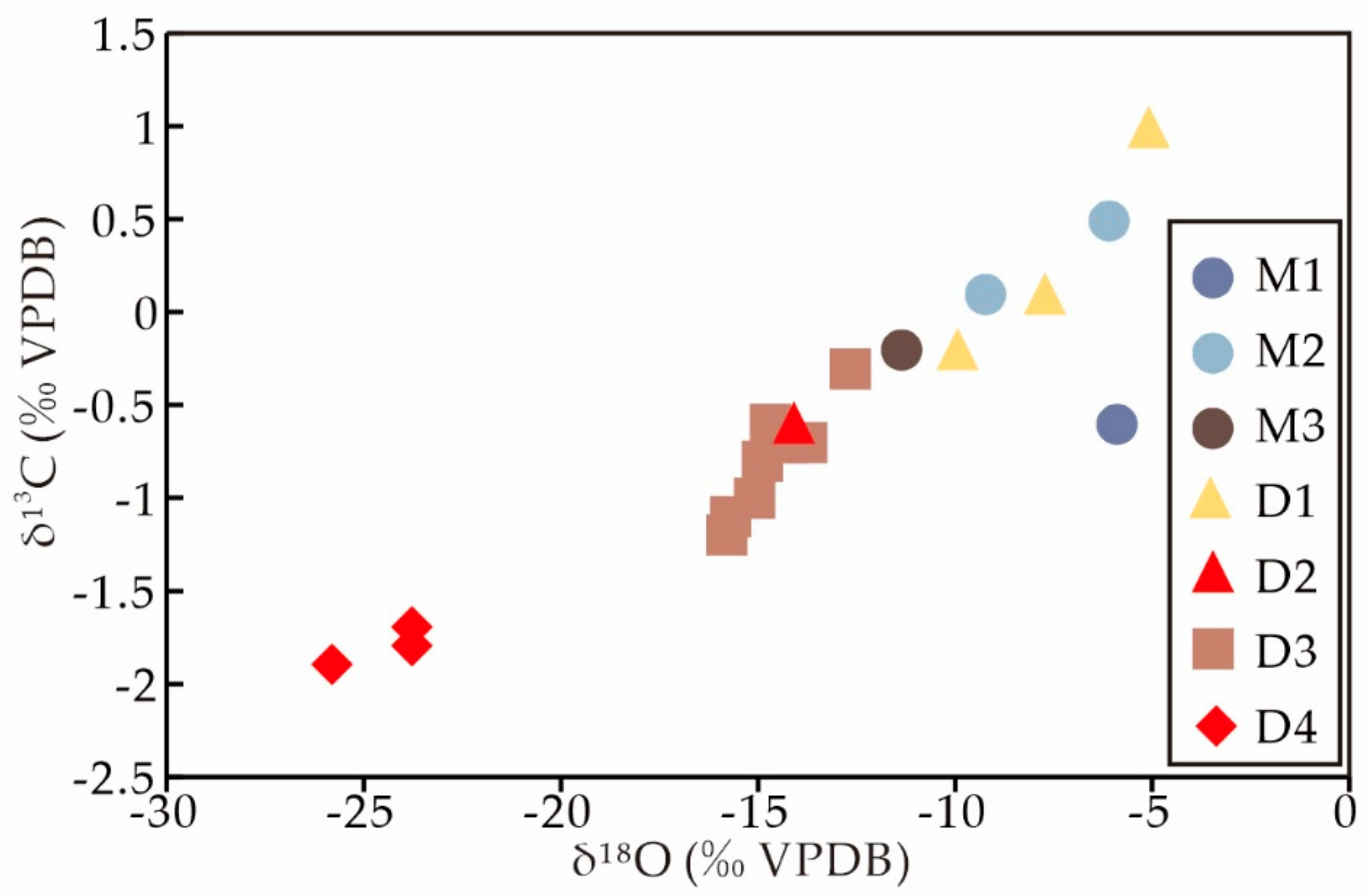
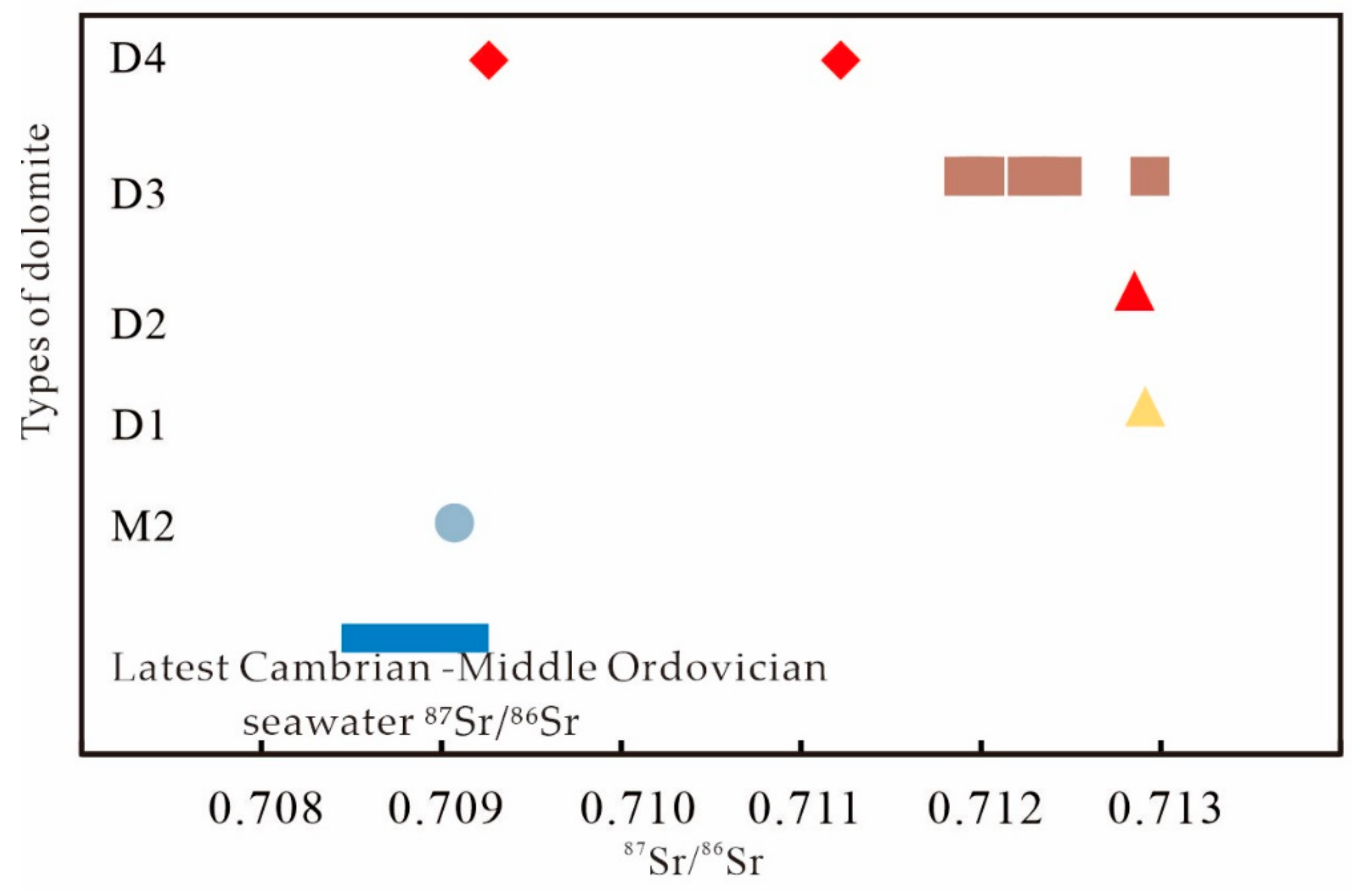

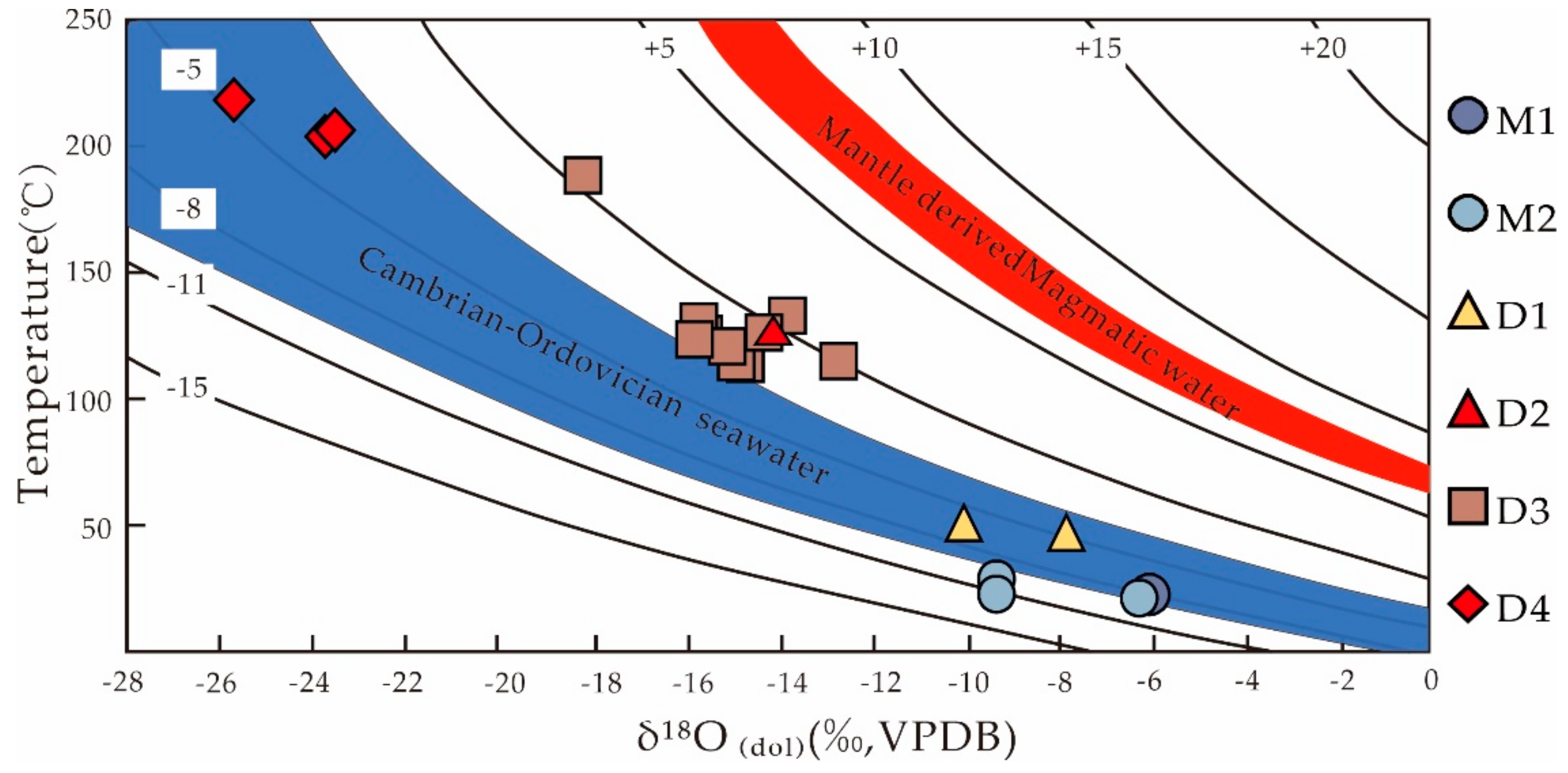

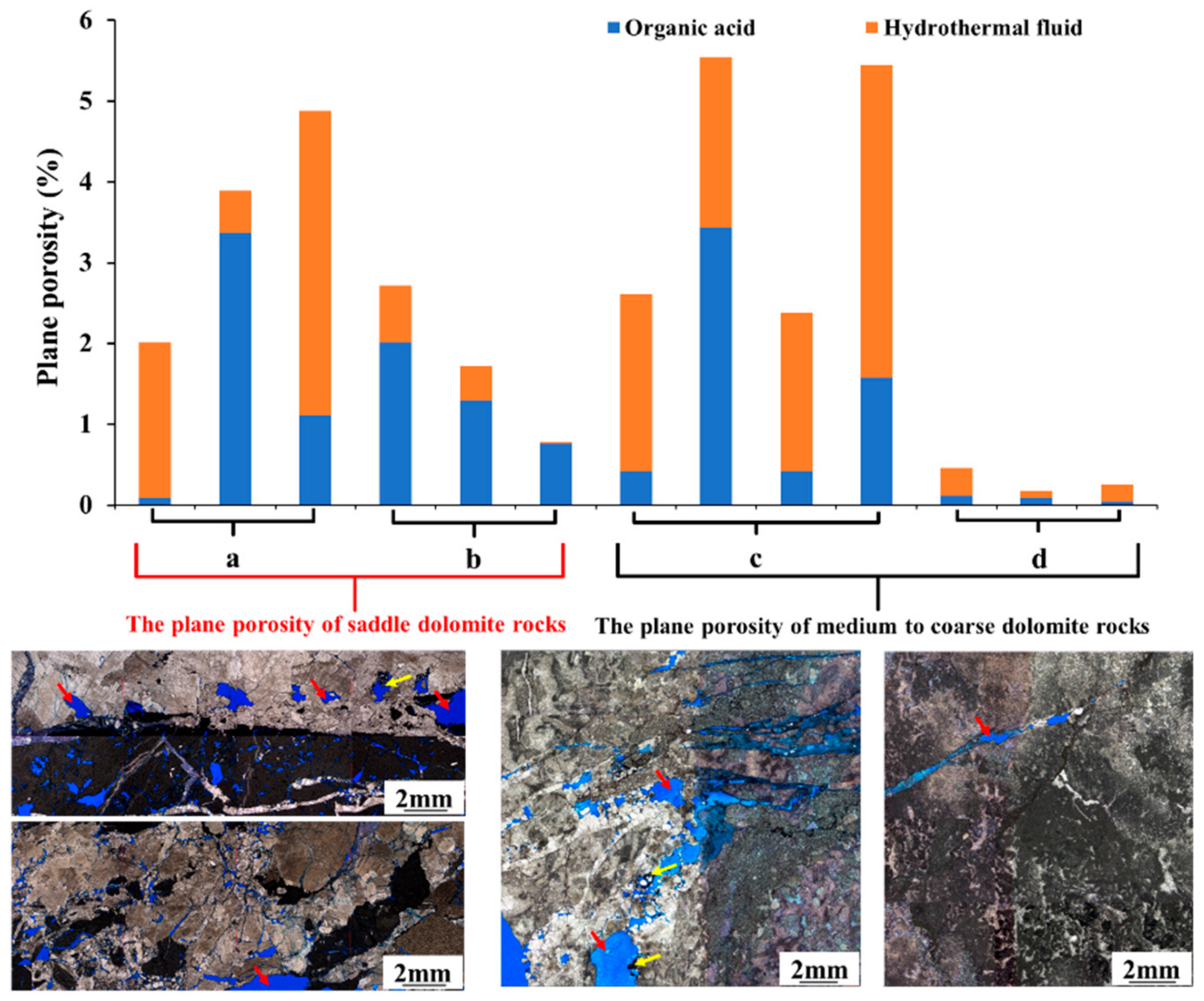

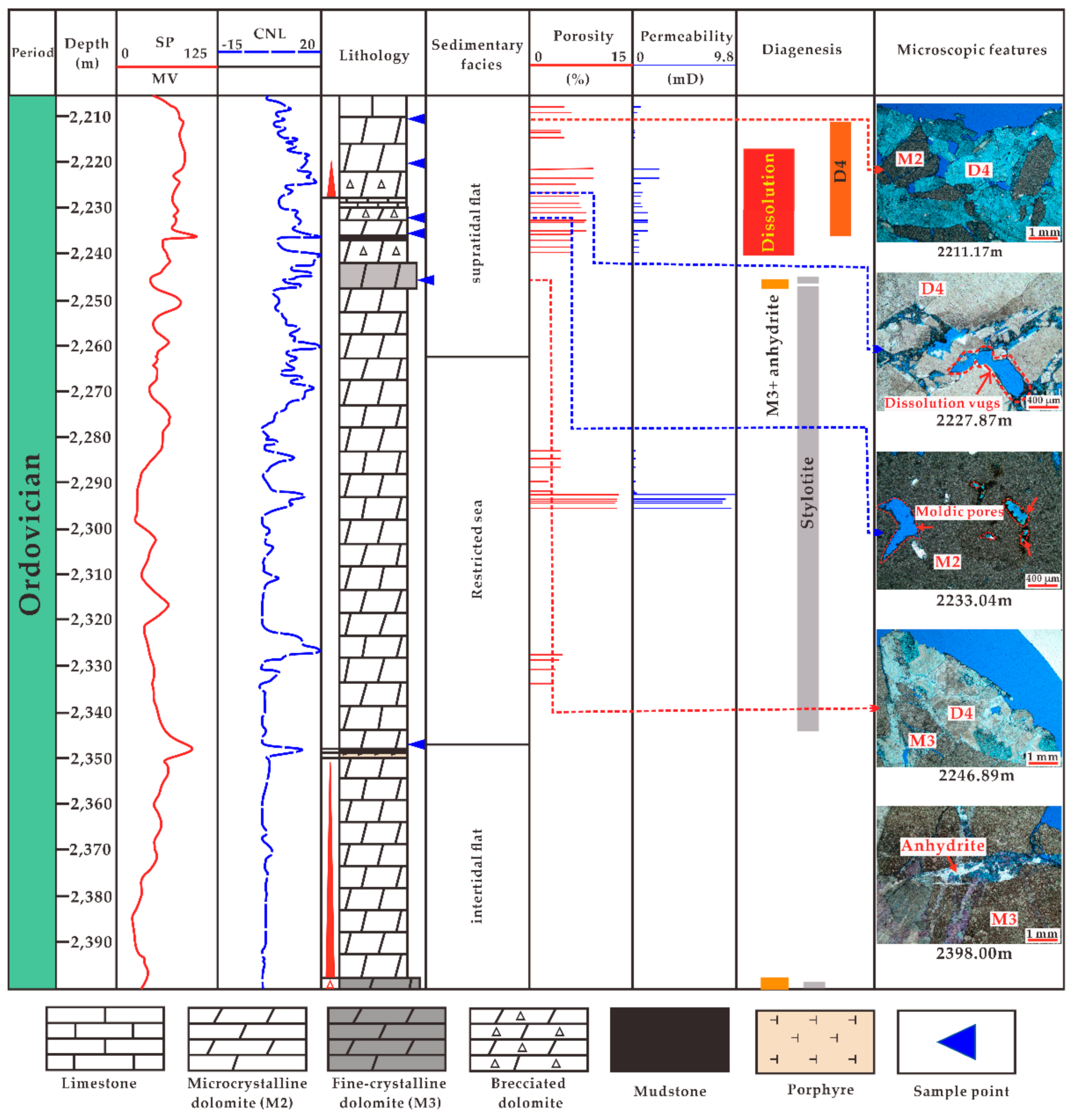
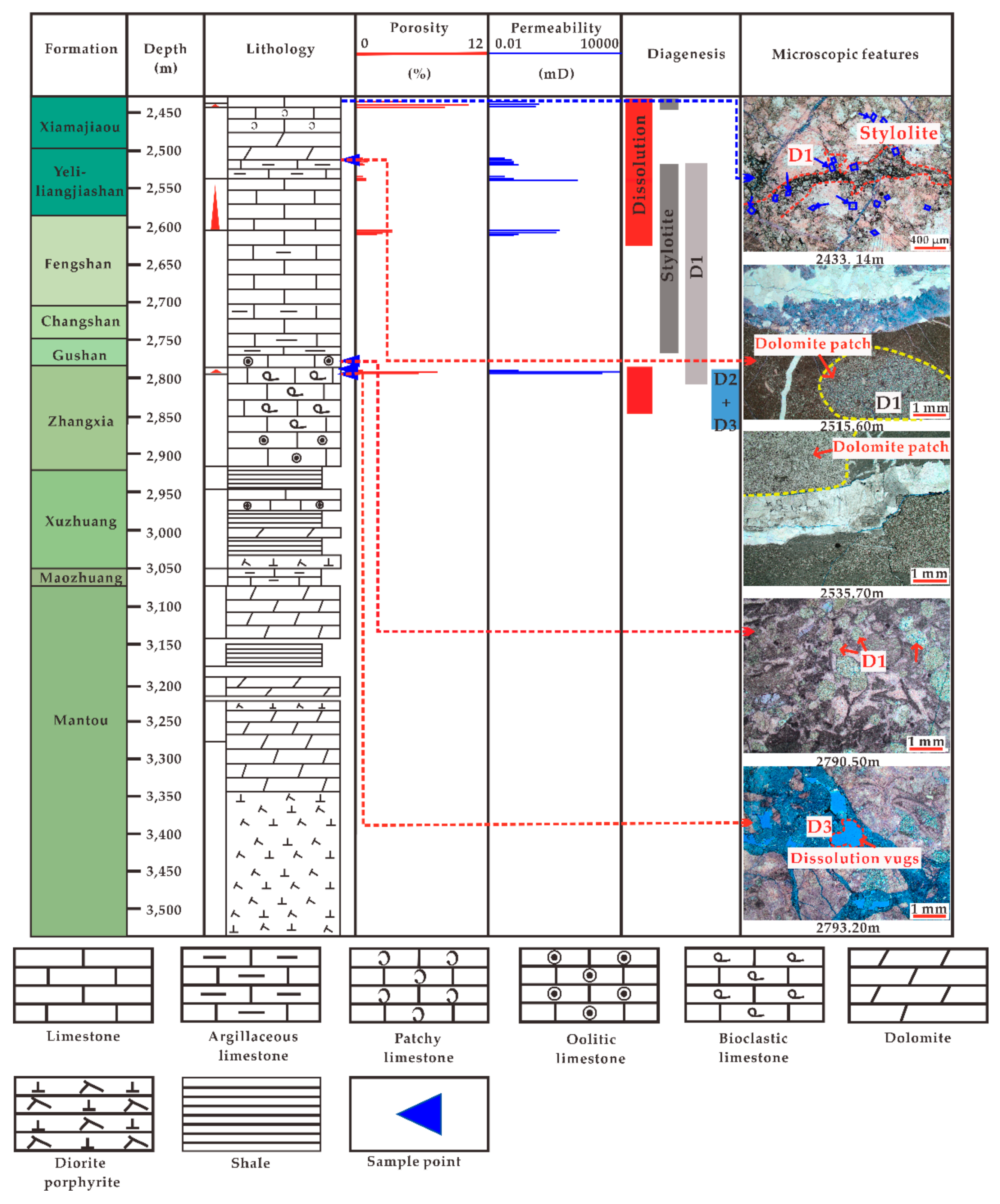

| Well | Sample Depth (m) | Formation | Lithology Description | Sample Analysis |
|---|---|---|---|---|
| Bg26 | 2515.6 | Yeli-Liangjiashan | Limestone | Microscopic observation |
| Bg26 | 2790.5 | Zhangxia | Oolitic limestone | Microscopic observation |
| Bg26 | 2791.2 | Bioclastic limestone | C, O isotope; 87Sr/86Sr | |
| Bg26 | 2791.5 | Microscopic observation | ||
| Bg26 | 2793.2 | C, O isotope; 87Sr/86Sr | ||
| Bg26 | 2795.4 | Microscopic observation | ||
| Bg26 | 2795.5 | Grain limestone | Cathodoluminescence | |
| Bg26 | 2798.2 | Dolomitic bioclastic limestone | C, O isotope; 87Sr/86Sr | |
| Bg26 | 2801.9 | Calcareous dolomite | C, O isotope; 87Sr/86Sr; Cathodoluminescence | |
| Bg26 | 2803.5 | Algal limestone | Microscopic observation | |
| Bg22 | 2211.17 | Ordovician | Microcrystalline dolomite | Microscopic observation |
| Bg22 | 2219.27 | Microscopic observation | ||
| Bg22 | 2233.04 | C, O isotope; 87Sr/86Sr | ||
| Bg22 | 2236.4 | C, O isotope; 87Sr/86Sr | ||
| Bg22 | 2236.76 | Argillaceous dolomite | Microscopic observation | |
| Bg22 | 2246.89 | Microcrystalline dolomite | Microscopic observation | |
| Bg22 | 2348.95 | Microcrystalline dolomite | C, O isotope | |
| Bg22 | 2398 | Fine-crystalline dolomite | Microscopic observation | |
| Bg22 | 2399.1 | C, O isotope | ||
| Bgx15 | 2238.9 | Ordovician | Microcrystalline dolomite | C, O isotope |
| Bg11 | 2233.04 | Ordovician | Microcrystalline dolomite | 87Sr/86Sr; Cathodoluminescence |
| Bg11 | 2434.5 | Argillaceous limestone | C, O isotope | |
| Bg11 | 2435.24 | C, O isotope; 87Sr/86Sr | ||
| Bg11 | 2449.5 | Cathodoluminescence |
Publisher’s Note: MDPI stays neutral with regard to jurisdictional claims in published maps and institutional affiliations. |
© 2022 by the authors. Licensee MDPI, Basel, Switzerland. This article is an open access article distributed under the terms and conditions of the Creative Commons Attribution (CC BY) license (https://creativecommons.org/licenses/by/4.0/).
Share and Cite
Zhang, X.; Li, Q.; You, X.; Ma, L.; Jing, A.; Tian, W.; Wen, L. Characteristics and Formation Mechanism of the Lower Paleozoic Dolomite Reservoirs in the Dongying Depression, Bohai Bay Basin. Energies 2022, 15, 2155. https://doi.org/10.3390/en15062155
Zhang X, Li Q, You X, Ma L, Jing A, Tian W, Wen L. Characteristics and Formation Mechanism of the Lower Paleozoic Dolomite Reservoirs in the Dongying Depression, Bohai Bay Basin. Energies. 2022; 15(6):2155. https://doi.org/10.3390/en15062155
Chicago/Turabian StyleZhang, Xuemei, Qing Li, Xuelian You, Lichi Ma, Anyu Jing, Wen Tian, and Lang Wen. 2022. "Characteristics and Formation Mechanism of the Lower Paleozoic Dolomite Reservoirs in the Dongying Depression, Bohai Bay Basin" Energies 15, no. 6: 2155. https://doi.org/10.3390/en15062155
APA StyleZhang, X., Li, Q., You, X., Ma, L., Jing, A., Tian, W., & Wen, L. (2022). Characteristics and Formation Mechanism of the Lower Paleozoic Dolomite Reservoirs in the Dongying Depression, Bohai Bay Basin. Energies, 15(6), 2155. https://doi.org/10.3390/en15062155






